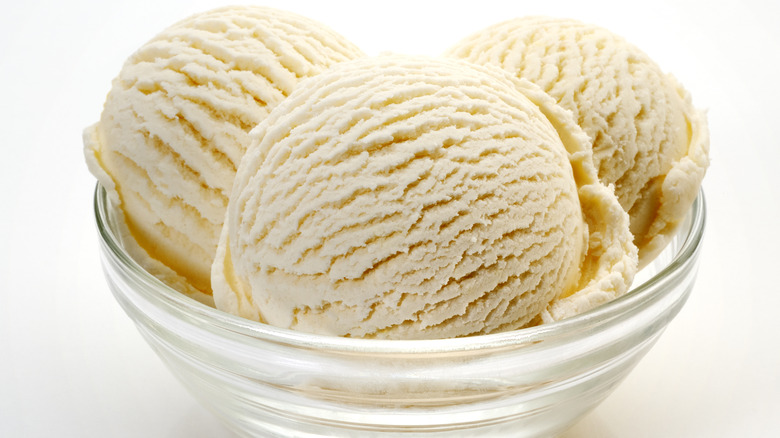Ice Cream Was Invented Much Longer Ago Than You'd Think
Nothing satisfies your craving for a cold, sweet treat like a scoop of ice cream. Homemade with a Ninja Creami, purchased from a local stand — even fast food ice cream will do. And people have been serving it up for centuries. As it turns out, ice cream, in one form or another, has been around for thousands of years, with its forerunners, iced beverages, appearing in ancient Mesopotamia around 4000 BCE and ancient Greece in the 400s BCE. Elsewhere in the ancient world, Romans mixed snow and ice with different fruit juices to make frosty desserts and beverages.
The true ancestor of our modern-day ice cream was invented in ancient China. Chinese farmers began domesticating animals and producing milk by around 2000 BCE. Soon after this, the nobility of this country figured out that they could turn one of their favorite rice-y milk dishes into a cool treat with snow sourced from the mountains. What started at the top made its way down to the everyday people of China, who were able to purchase milk ice from street vendors.
A bit of cream and salt, and voilá
If we're talking about the beginnings of actual ice cream (rather than milk ice), that takes us back to Medieval Italy, where the recipe for Chinese milk ice finally reached Europe, no doubt in large part due to Italy's prime geographical location as the gateway from the East to Europe. By the 1500s, milk ice (supposedly) made its way to France when Catherine de' Medici of Venice married Henry II. Though this story is apocryphal, it may be that the cooks at Medici's wedding banquet served the world's first ice cream, swapping out the lighter milk in the recipe for heavier, richer cream.
Just after Catherine married Henry, Blasius Villafranca discovered the method of freezing ice cream by mixing the ingredients in a container which was placed inside of a larger container filled with snow (or ice, if available) and salt or saltpeter; the snow/ice/salt mixture caused rapid freezing of the milk/cream and other ingredients. Not a bad discovery for the 16th century!
About 100 years later in England, ice cream received its first formal mention by name, in the whole of history. It was served at the table of Charles II — and only at his table — as part of the celebration to mark a decade since he had been restored to the throne of England. Alas, ice cream was still considered a great delicacy and the purview solely of the fabulously wealthy.
Americans have loved ice cream from the start
The first record instance of ice cream being eaten in what would become America happened in Maryland. After dining at the table of Maryland governor Thomas Bladen in 1744, William Black recounted his experience with ice cream at the dinner, calling it, per Preservation Maryland, "fine" (as in "fine ice cream"). By the time of the Revolutionary War and beyond, some of the Founding Fathers — who were wealthy, landed gentlemen, remember — were remarkably fond of the dish, with Thomas Jefferson writing down a complicated recipe for French-style vanilla ice cream (you can use this much simpler vanilla ice cream recipe if you want to eat like Jefferson at home) and George Washington shelling out $200 for ice cream in a single summer — that's equivalent to nearly $7,000 today. It seems our first president had quite the sweet tooth.
As inventions so often do, ice cream trickled down from the rich to the masses, and by the 1800s inventors were creating new ways of serving up an already old favorite. A 7-year span between 1874 and 1881 saw the invention of both the ice cream soda and ice cream sundaes. Just five years later, the word "milkshake" entered our lexicon, and then in 1904, waffle cones were invented at the St. Louis World's Fair, born out of necessity when an ice cream vendor ran short on paper cups. After thousands of years of slow development, by the turn of the 20th century, ice cream had evolved into more or less the form that we know and love today.


